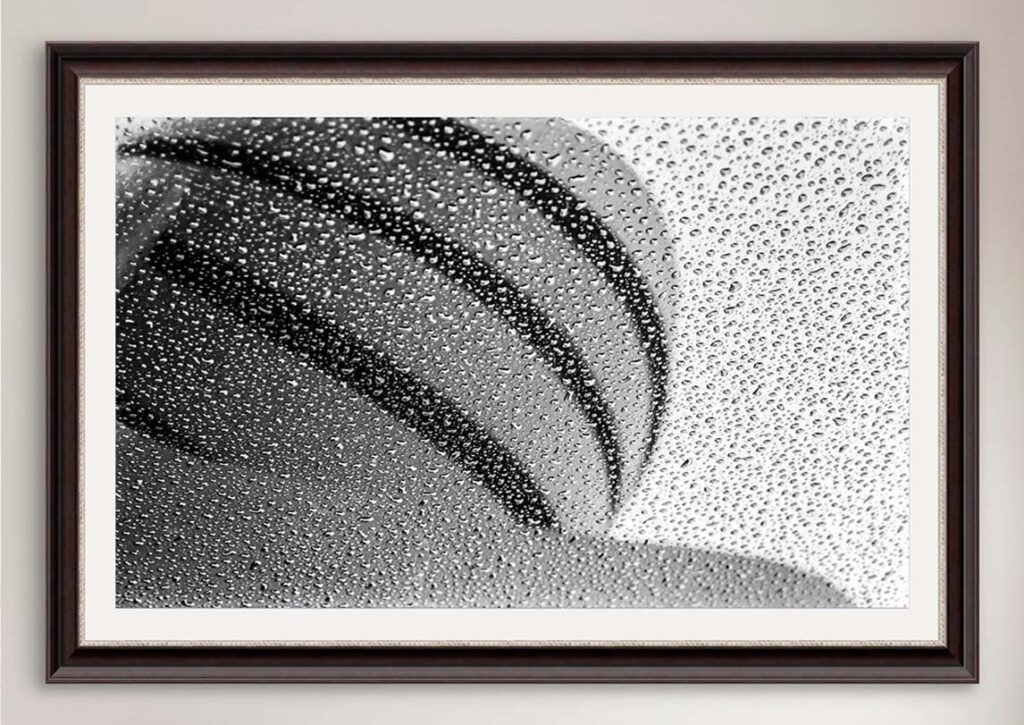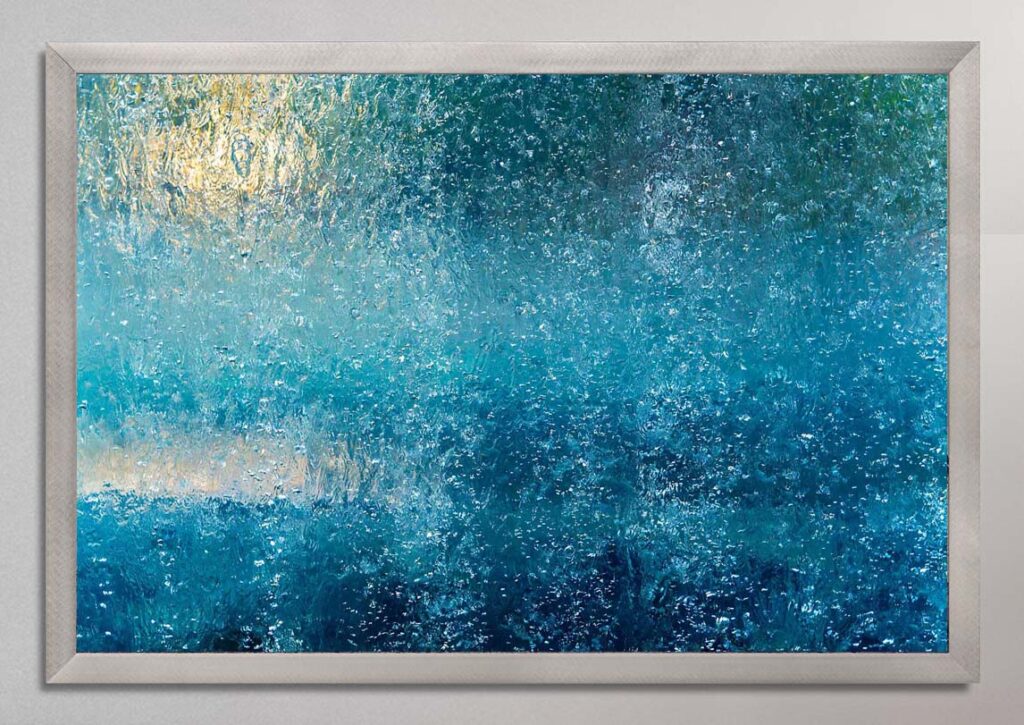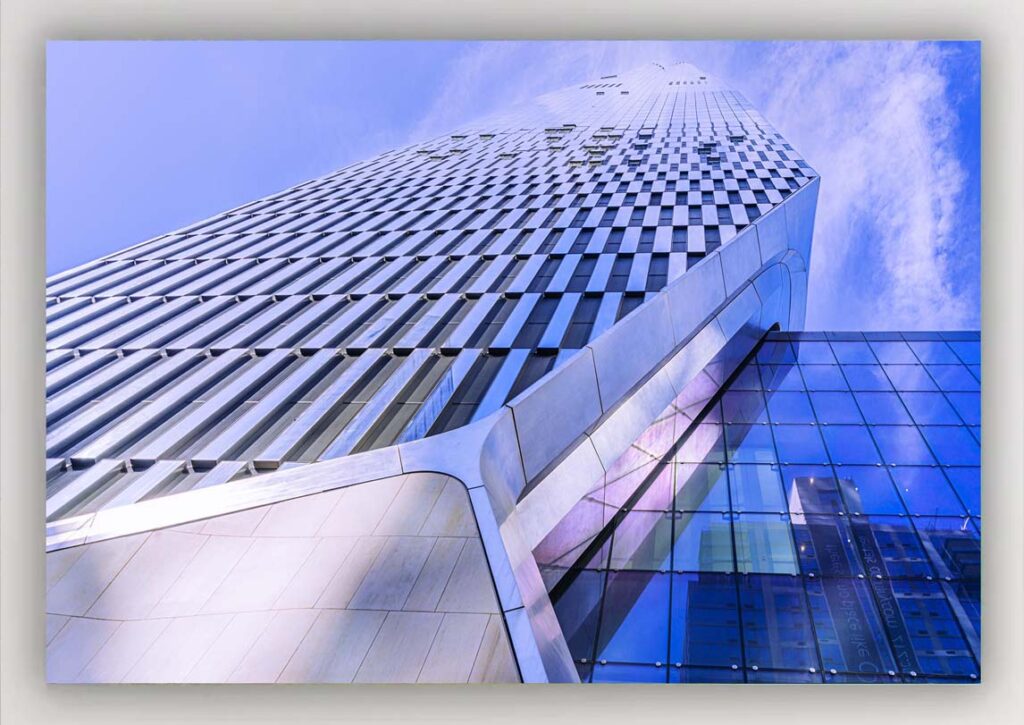-
LIMITED EDITION
-
OPEN EDITION
-
ABOUT
Who are the foreigners
in this succession of never broken glass,
in this homeland of fragments, of mirrors,
where we don’t know
what is the reflection
whom the reflected.
-Patricio Loizaga (1954-2006)
This poem -a turning point in my art journey, inspired an art curator to feature my images on his book cover and give me my first solo New York exhibition

Photography became my voice when words failed me, emerging from a childhood where feeling unheard in a dysfunctional environment made the visual world a vital means of expression. Lacking a consistent structure, I built an internal shield. As an adult, this coping mechanism created a profound disconnect: a vulnerable self hidden behind a capable mask, often mistaken for reality and fueling anxiety.
This core friction drives my artistic language. My fascination with distorted reflections is a central metaphor for this mask, the disparity between internal feeling and external image, and the unsettling sense of a warped reality. The geometric lines I seek in urban landscapes represent a deep-seated need for the structure and limits that were missing from my past, a visual search for order. And moments of abstraction give form to the complex, often difficult emotions arising from this inner landscape.
Recognizing these connections, my photographic practice evolved beyond aesthetics into a quest for self-discovery and healing – a vital path for processing these experiences.
This deeply personal struggle feels acutely resonant in our world today. The safe internal world I built mirrors the online ‘bubbles’ we inhabit, and the capable mask finds parallel in the curated identities we project. This friction between felt reality and the presented image reflects the broader societal gap between verifiable facts and the distorted ‘realities’ amplified by polarization and misinformation.
Ultimately, my art’s exploration of warped reflections and fragmented perception continues to chart this territory, a persistent search for clarity and voice in a world struggling to find its clear reflection. By recognizing that reality is always subjective and the truth is relative to a point of view, we can cultivate dialogue and foster empathy.

Shooting in RAW format helps my creative process by preserving more details and colors, and have a higher dynamic range and wider color gamut than other file types like JPEG, allowing me to adjust contrast, brightness, white balance, color saturation, and tonal range without affecting the quality. The resulting “edited” image is often a new reality based on a cityscape, a landscape, or abstract incorporating elements of surrealism, geometry, high contrast and the realities and diversities of human life.

Marcelo Chechik is an Argentinean visual artist established in the San Francisco Bay Area since 2018 after living in Buenos Aires, Miami, and Sao Paulo. He studied Architecture, and Graphic design at the University of Buenos Aires, Argentina. He also studied Film and Video Production with Rodolfo Hermida.
Marcelo’s background for his artistic inspiration were the perceptual illusions of M.C. Escher and Victor Vasarely, the reality-bending narratives of Isaac Asimov and Jorge Luis Borges, and the raw emotional expression found in Jackson Pollock’s paintings.
His work has been exhibited in museums, galleries, universities, and international art fairs in the United States, South America, and Europe.
Some of his solo exhibitions include: “Images of New York” at New York University -King Juan Carlos of Spain Center (NYC), “Marcelo Chechik Photographs” at Beech River Heritage Museum (Tennessee,TN), ”Multiverses” at Hebraica Gallery (São Paulo), “The Journey to the promised land” in collaboration with Karina Chechik at Bernice Steinbaum Gallery (Miami), and “Chechik/Chechik” at Jackson State Community College (Jackson,TN).
Selected group shows include: “By Degrees: Art and our Changing Ecology” at the Huntington Beach Art Center (Huntington Beach, CA), Bienal “Reflexão Arte Hoje” (São Paulo), “Imago Mundi Collection” at Laura Haber Gallery (Buenos Aires), “Four from Argentina” at the Orlando City Hall (Orlando, FL), “Argentina 2002” at the Broward County Main Library (Miami), PARTE Art Fair (São Paulo), Art Takes New York (NYC), CasaFOA (Buenos Aires), and Scope Art Fair during Miami Art Week.
Marcelo, in collaboration with his sister Karina Chechik, was invited by Ediciones Polígrafa in Barcelona to create a series of lithographs. These works were subsequently showcased at prominent art fairs, including Art Basel, Art Basel Miami, ARCO Madrid, and Art Cologne.
His Video installations have been exhibited at Bernice Steinbaum Gallery (Miami), Oolite Arts (Miami Beach), East Tennessee State University (Johnson City, TN), Arte BA, Recoleta Cultural Center, Buenos Aires Photo, and San Martin Cultural Center (Buenos Aires). He also created Video Art portraits based on other artists works such as Wolfgang Luh (Germany), Karen Rifas (USA), Karina Chechik (Argentina), Jesús Marcos (Spain), Manuela Pintos Tezanos (Argentina), Arturo Mosquera (USA), and Al-Andaluz Flamenco (Argentina).
marcelochechik.com was selected by The Ivy Plus Libraries Confederation to be included in its Latin American and Caribbean Contemporary Art Web Archive, as a notable contemporary Latin American artist. The Archive is an initiative developed by art and architecture librarians at Brown, Columbia, Cornell, Dartmouth, Johns Hopkins, Harvard, Princeton, Yale Universities, and the Universities of Chicago and Pennsylvania.
Chechik was awarded First Prize in the Coca Cola in the Arts in the category of video installations and First Prize at the Bienal Reflexão Arte Hoje in São Paulo. He has been represented by Bernice Steinbaum Gallery in Miami and ROOM 8 Gallery in São Paulo.
“From the beginnings of the universe, travels and journeys have marked human beings. Even when confronted with the unknown, such travels have an implicit dream. For Marcelo Chechik, his journey to the United States has left a deep imprint in their work, not only for the meaning itself of confronting a new culture (so frequently sublimated) but also for the uprooting and abandonment implied in it. Taking into account all the places, images, smells, etc., it has accumulated with experience, the brain finds parallels almost as an obligation and an unconscious task. “…” It’s inevitable to find common points with the individual reality immigrants come from. That is why some of Marcelo’s photographs turn the Vietnam monument into the protagonist of his work to establish a parallel with the obelisk dedicated to the soldiers fallen in the Malvinas (Falkland Islands) war. In his photographs, Marcelo seeks to reflect the spontaneous and ephemeral reality using the richness offered by the image at the very moment it has been shot, without manipulating it.”
Marisol Martell, Art Nexus Magazine
www.artnexus.com/karina-and-marcelo-chechik
Marcelo´s photographic images and video installations of New York’s skyscrapers and Washington´s historical monuments acquire, within the context of the exhibition, a new powerful meaning. His approach questions ideals of freedom, security, and economic prosperity that can no longer be taken for granted.
Their current work also quotes John F. Kennedy, Martin Luther King Jr., Abraham Lincoln, and Emma Lazarus, and guides us to a new critical dimension, an emotional one that touches us all. Although the dreams still exist, they must be seen from a different perspective in this exhibition.
His work is a deep and sensitive reflection (as reflejo and/or reflexión) of the gap they perceive among the symbols, the expectations, and the realities of a promised land.”
Francine Birbragher, curator of Frost Art Museum
“Like all Argentinians that I have met, the Chechiks regard Borges as their great thinker. In their current body of work not only is Borges quoted but also John F. Kennedy, Martin Luther King Jr., Abraham Lincoln, and Emma Lazarus. The Chechiks have shown me that there is a relationship between Borges with our great thinkers. Borges speaks of the journey as a labyrinth in which there are no definitive answers. He suggests that discovering the realities is part of the dream. Thank you, Karina and Marcelo, your research was unparalleled. It is ironic that your exhibition opens May 25th, Independence Day for Argentina, and closes July 4th, Independence Day for the United States. Your efforts remind us that there can be a dream in this promised land.”
Bernice Steinbaum, Bernice Steinbaum Gallery
“Marcelo Chechik explores the relationship between man and his visual environment, most specifically large buildings, through the use of his photography. As is witnessed in this exhibition, mirrors and reflection have a considerable place in his work. The reflected light and shadows give the architecture a sense of pulse. Wherever his buildings are photographed, this artist finds another dimension for them, one connected to his Argentine roots. His photographic eye connects the remembrances of the edifices at home with those of a variety of metropolises.”
Michael McManus, Curator Terrace Gallery, Orlando City Hall – Orlando, FL.
“Angled edges of skyscrapers blend into the slopes and curves of fuzzy clouds in Marcelo Chechik’s art exhibit at The Ned. The Argentinean photographer’s works feature ornate, old-world architecture and sleek, shiny modern buildings in New York City. Some of the pieces feature double images or distorted reflections. “
Kim Thomas, Art Critic, The Jackson Sun Jackson, Tennessee, TN.
“Marcelo Chechik’s work explores the relationship between man and the visual environment. For Chechik, reality is always a point of view to a perspective. Chechik’s portrayals of large cities and buildings explore the ideas of perception, essence and contradictions. “
Euridice Miranda, Curator, Broward County Main Library Fort Lauderdale, FL.
“Intriguing photographer Marcelo Chechik engages himself with relations between reality and illusion as revealed through modem buildings’ glass facades.”
Philip E. Bishop, Art Critic, Orlando Sentinel – Orlando, FL

By signing up, you agree to receive non-transactional emails from us.
Size Small: 12×18 in, 30×45 cm. First Edition Availability of 150.
Size Medium: 20×30 in, 51×76 cm. First Edition Availability of 50.
Size Large: 24×36 in, 61×91 cm. First Edition Availability of 35.
Size X-Large: 40×60 In, 101×152 cm. First Edition availability of 12.
Size Small: 12×18 in, 30×45 cm.
Size Medium: 20×30 in, 51×76 cm.
Size Large: 24×36 in, 61×91 cm.

Prints are made by the best-approved laboratories on Fine Art, producing images with smooth tones and rich colors made with care on a variety of exquisite Fine Art Papers using a high-resolution large format inkjet printer.
Sizes: 12×18 in to 40×60 in

Each moulding profile is carefully inspected to meet gallery quality standards. Our genuine natural solid wood mouldings have a naturally rich finish and grain that can vary slightly from frame to frame. We take great care to ensure your frame is free of flaws and meets your high standards. This individual attention makes our frames all the more dramatic and rich, each a beautiful hand-made product you’ll be proud to present and hang. Additionally, frames can be added to Metal Prints.
Sizes: 12×18 in to 40×60 in

Framed Metal Prints are perfectly finished without glass. These archival metal prints are produced using dye sublimation—a process that infuses the image directly into the aluminum. Unlike cheaper direct-print methods, this technique bonds the ink within the surface itself, creating an ultra-durable, scratch- and water-resistant print with superior sharpness and color fidelity. The result? A high-definition image that glows with vivid detail and maintains its brilliance for decades.
Each Metal print is made of an aluminum panel is 1/16″ thick with a white base coating to ensure accurate color reproduction. Prints are mounted with a ¾” aluminum float frame and a French cleat for secure, ready-to-hang display.
To complement this unique printing method, we offer a selection of Metal and Wood Frames in a variety of colors and styles.
Sizes: 20×30 in to 40×60 in

The final product Fujiflex Acrylic print is a ready to hang, finished art masterpiece. It is museum quality grade, designed to maintain color vibrancy for over 120 years. It boasts unmatched detail and print sharpness, superior color range ability, and an incredible depth and dimensionality which creates an almost 3D look.
Fine Art Prints get extra depth and radiance when paired with the ultra-smooth, high gloss surface of Fujiflex features a warmer base tone and extra rich colors. This depth helps Fujiflex Crystal Archive Prints reflect light, which makes them extra brilliant.
Each Fujiflex print is face-mounted to 1/4″ or 1/8″ Non-Glare Acrylic Face using an optically clear archival adhesive, then backed with a rigid DiBond panel. A Roma float mount system is affixed to the back, providing a sleek, ready-to-hang presentation using a French cleat.
Sizes: 20×30 in to 40×60 in
Each Limited Print is meticulously crafted and signed, reflecting Marcelo’s commitment to excellence and the enduring uniqueness of his work. When you invest in a Marcelo Chechik print, you’re not just purchasing artwork—you’re acquiring a timeless treasure that embodies creativity, craftsmanship, and authenticity.
All large format prints (size Medium and above) are accompanied by a Certificate of Authenticity, ensuring their value as a genuine collector’s item.
All unframed prints will ship out within 5 business days of the order being placed. In addition to our processing timeline, please allow for time in transit. Most orders take 3-5 business days in transit.
We currently offer custom framing and mounted prints for customers in the continental U.S. and Canada.
* denotes required fields
We will process the personal data you have supplied in accordance with our privacy policy (available on request). You can unsubscribe or change your preferences at any time by clicking the link in our emails.